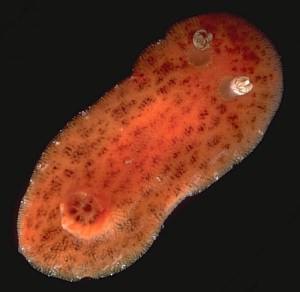
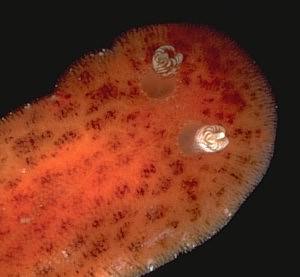
Rostanga calumus
Rudman & Avern, 1989
Order: NUDIBRANCHIA
Suborder: DORIDINA
Family: Dorididae
DISTRIBUTION
Known from New South Wales, Victoria, Tasmania and the southern part of Western Australia.
PHOTO
Rocky Cape, Tasmania, Australia. two specimens (13, 16 mm long alive), 22 February 1984, AM C141312. Photos: Bill Rudman
See also R. calumus - Radula.
The animal ranges in colour from a reddish-orange to a yellowish-orange with patches of brown specks on the dorsal epithelium between the caryophyllidia. The closely spaced caryophyllidia on the mantle are a translucent orange except for the colourless protruding spicules. There are some scattered white specks and patches near the mantle edge some of which are small mantle glands and some just pigmentation. The rhinophore stalk is transparent and the club is translucent with a heavy dusting of white with some brown patches. The terminal knob is white. The overall impression is that the rhinophores are white but in some cases unusually heavy brown patching makes them appear quite brown. The gills are translucent with a colour similar to that of the background mantle. Microscopic brown specks are scattered over the gills. Across the flattened tip of each gill is a submarginal white band often with a row of brown specks forming a second band beneath it. The submarginal white band on each gill gives the complete gill circlet a characteristic submarginal white rim.
The mantle is ovate and is similar in shape to R. arbutus. The rhinophores have a stout stalk and the club consists of nine to ten almost vertical lamellae with a tall inflated terminal knob in the posterior mid-line. There are seven to nine tripinnate gills and the upper pinnules are arranged to give a wide flattened tip to each gill. The gills form a short upright cylinder.
The egg mass and development have only been observed on one occasion (Hunter & Woodward, personal communication, AM C152563). The eggs were a pale pink-orange and laid in a broad spiral ribbon, with shallow scallops along the outer edge. Planktotrophic larvae developed quickly beginning to hatch five days after oviposition and continuing to hatch for three further days. We have photographs of two specimens from Sydney associated with orange sponges. The two sponges appear to be different species. In neither case were the sponges collected so identification is impossible. One specimen from Western Australia (WAM 787-83) was found associated with an orange sponge which has been identified as Clathria (Clathria) cf. partita (.Microcionidae).
References:
• Rudman, W.B. & Avern, G.J. (1989). The genus Rostanga Bergh, 1879 (Nudibranchia:
Dorididae) in the Indo-West Pacific. Zoological Journal of the Linnean Society 96: 281-338.
Rudman, W.B., 2002 (February 4) Rostanga calumus Rudman & Avern, 1989. [In] Sea Slug Forum. Australian Museum, Sydney. Available from http://www.seaslugforum.net/find/rostcalu
Related messages
Rostanga calumus from S.E. Australia
April 24, 2002
From: John Chuk
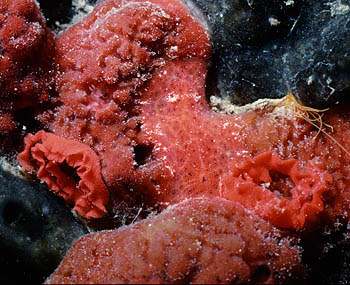
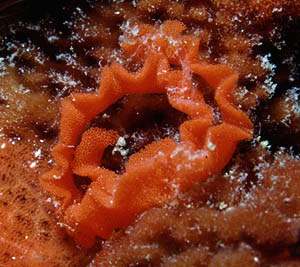
Dear Bill,
I read your message regarding Rostanga calumus and its egg-ribbon only hours after receiving slides of a specimen I photographed at Flinders Pier, Victoria, Australia, on April 9th, 2002.
I found several egg-ribbons on pylons and looked in vain for the nudibranch responsible. Then I found these egg-ribbons on a red sponge and close inspection revealed a well-disguised specimen of R. calumus. It measured 18mm in length and was found at a depth of 3m on a pier pylon.
The upper photo shows the two egg-ribbons on the sponge with the specimen of R. calumus between them. The second shot is a close up of the egg-ribbon on the right in the first shot.
I found six specimens of R. calumus at the site and many egg-ribbons but failed to observe the ribbon being laid. I did see a mating couple on a small red sponge and when I returned the next day the nudibranchs were not to be found but a half-spiral of a similar egg-ribbon had been laid on the sponge. No doubt circumstantial evidence but it does mount up.
Best wishes,
John.
jchuk@giant.net.au
Chuk, J., 2002 (Apr 24) Rostanga calumus from S.E. Australia. [Message in] Sea Slug Forum. Australian Museum, Sydney. Available from http://www.seaslugforum.net/find/6803Thanks John,
I wish all scientific discovery was as quick as this! I agree that we can be pretty confident that the egg ribbons are those of
Cheers,
Bill Rudman
The egg ribbon of Rostanga calumus
April 23, 2002
From: Bill Rudman
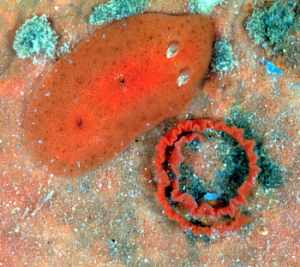
On my recent field trip to southern New South Wales and nthn Victoria I was lucky to turn over a large flat rock and find a Rostanga with two egg ribbons which looked like one of those in Audrey Falconer's recent message.
Data: S. of Secret Bch, Mallacoota, nthn Victoria, 26 February, 2002. Under rock at low tide. 24mm long alive, AM C408090.
Even though I named these species, I must admit to having been uncertain of its identity until I had a chance to look at its radula, which I have just been able to do. In a separate message I have posted a couple of SEM photos showing that it is Rostanga calumus. I kept the Rostanga alive for 3 days in the hope it would lay another egg ribbon and so prove its 'ownership' but unfortunately it wouldn't oblige. The difference in colour of the egg ribbons reflects the stage of larval development, the ones in the lower right ribbon being just about to hatch as veliger larvae. Although we can't be 100% certain that this is the egg ribbon of R. muscula, until we find one in the act of laying, I am pretty confident that it is. This is a useful piece of information as it is one of the few species whose egg ribbon morphology was unknown.
Looking again at Audrey Falconer's recent message I wouldn't be surprised if her 2 egg masses were from different species. From my Mallacoota photos it looks like the egg ribbon on R. calumus is about one and one half whorls and the free edge has relatively large folds. The photo in Audrey's message from Marengo, Victoria [lower right] seems identical. However the other photos, which show an egg ribbon being layed in an aquarium, shows an egg ribbon which is more than 3 whorls and has the free edge bearing many small tight folds. This is more like that found in Rostanga bifurcata. The animal also looks quite like R. bifurcata as well. The egg ribbon of R. bifurcata usually has many more whorls than this, but strange things happen when egg ribbons are layed in strange places.
Best wishes,
Bill Rudman
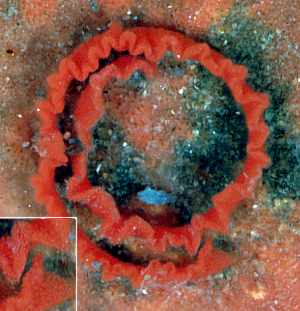
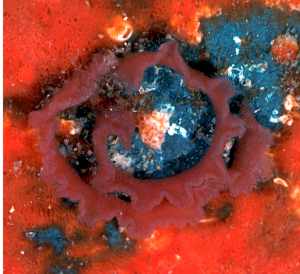
Radula of Rostanga calumus
April 23, 2002
From: Bill Rudman
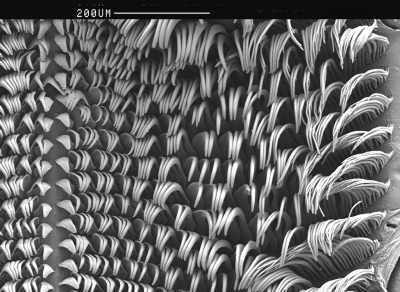
PHOTOS: Scanning electron micrographs of the teeth of Rostanga calumus [AM C408090]. Upper Right: Section od radula showing the central teeth and the rows on the right side of the ribbon. Lower Left: The tips of the long outer radular teeth from right side of ribbon. Lower Right: the central teeth on each side of the midline. Photos: Alison Miller.
In a separate message I have posted some photos of the egg ribbon of a species of Rostanga which I was able to identify by examining its radula. Here are the photos. All species of Rostanga have a radula which has an innermost tooth, on each side of the midline, which is small, wide-bladed and denticulate on the inner edge. Outside this tooth, in each row, there is a series of simple hook-shaped teeth which get gradually longer towards the outside edge of the ribbon. At the edge of the ribbon are usually a cluster of very long teeth often with many long finger-like terminal denticles. The shape of the innermost and the outermost teeth in each row are usually very distinctive for each species. I have already included pages on the Forum illustrating the radula of most species of Rostanga, including a R. calumus radula Page. This animal is clearly R. calumus.
Best wishes,
Bill Rudman
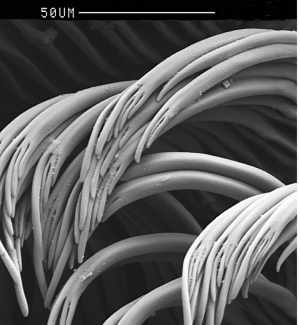
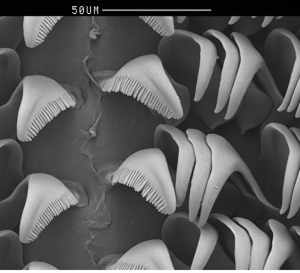
Re: Rostanga calumus? from S.E. Australia
March 8, 2002
From: Audrey Falconer
Bill,
Everything in the photos has been preserved, and under the terms of our collection permit is required to be lodged at the Melbourne Museum. I don't know if Bob has yet lodged them or not, but I will find out and see if I can get the animal to you. We've also photographed a juvenile (about half grown) animal at another time and I'll see if I can locate that one too.
Re colours: my husband is perpeptually complaining about variation in colours on different computer screens and is trying to adjust for them. I don't think the colours of any of the pictures are accurate - my memory reports them as a deep orange-red and the egg ribbon was the same colour and the live animal from 2 years earlier. If I locate the specimens to send them down to you I'll include the original slides as well.
Oh, I should have mentioned that the egg ribbon was found with no animal in sight, on a small rock without any sponges. The small rock was underneath a large one and there may have been a sponge on there (I don't recall) but there were no Rostanga there. I always assumed that this was a complete egg ribbon but looking at your photo of the multi spiralled ribbon I am now not sure!
Audrey
audrey@bluering.org.au
Falconer, A., 2002 (Mar 8) Re: Rostanga calumus? from S.E. Australia. [Message in] Sea Slug Forum. Australian Museum, Sydney. Available from http://www.seaslugforum.net/find/6215Dear Audrey,
Thanks for the feedback. By chance I found a specimen of Rostanga at Mallacoota in northern Victoria, Australia, last week. It was on an orange sponge with 2 egg masses, both of which look like the one in your photos. Interestingly the colour of the two egg ribbons was quite different, one a dull brick red and the other a bright orange red. My first job will be to have a look at the radula of the animal and identify it. I kept the slug alive for 2 days in the hope that it would lay an egg ribbon that I could definitely associate with it, but unfortunately it was either out of eggs or just unco-operative. I'll let you know the result.
Best wishes,
Bill Rudman
Re: Rostanga calumus? from S.E. Australia
February 12, 2002
From: Audrey Falconer
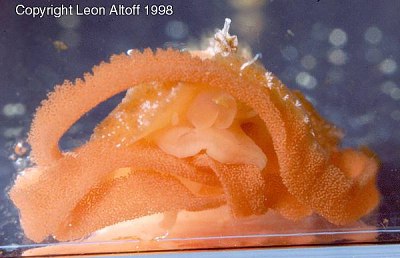
Bill,
Attached please find a picture of Rostanga calumus, the same animal in the act of laying eggs a day after capture (this photo shows the shape of the rhinophore nicely), and a separate photo of a complete egg ribbon. All have been identified by Bob Burn.
Data:
UPPER RIGHT, LOWER LEFT: Barwon Heads, Victoria, Australia, 5 December 1998.
LOWER RIGHT: Marengo, Victoria, 17 March 2001. Photos taken by my husband, Leon Altoff.
I disagree with your comments about the eggs being pink-orange - they are definitely orange-red and the same colour as the slug itself.
Audrey
audrey@bluering.org.au
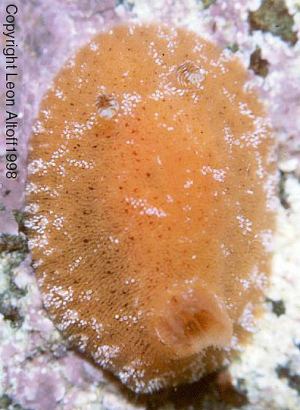
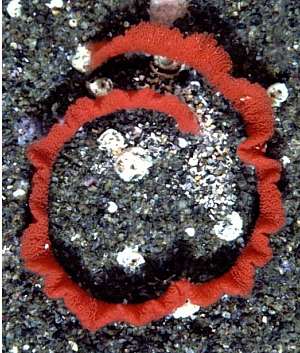
Dear Audrey,
Thanks for these photos. Firstly about your disagreement with the egg colour. At this stage in out knowledge of these animals, it is much too early to talk of who's right or wrong. My mention of colour was a report of an observation by a field naturalist whose information I respect. It is quite usual in this genus for there to be some variation in the colour of the eggs and the body. In fact ypur two photos show quite a difference in egg ribbon colour. Rostanga usually matches the colour of the sponge colony it is feeding on, and since sponges show quite a colour variation from colony to colony, this can lead to considerable variability in colour within a species.
One problem I have is with your identification. The egg ribbons and the slug look very like Rostanga bifurcata to me. If you have a look at the messages and photos of R. bifurcata you will see very similarly coloured animals and egg masses.
Unfortunately we don't have a photo of an egg mass which can be reliably identified as R. calumus so it is not possible to compare the egg ribbons of the two species. As I have said elsewhere, in parts of the world where more than one species of Rostanga occur, it is extremely difficult, if not impossible to identify species without looking at the radula. Only in species with very distinctive rhinophores, and/or distinctive egg ribbons can we positively identify them. It is possible that Rostanga calumus has an egg ribbon very similar to that of R. bifurcata but until we have been able to positively identify an animal which has laid eggs, from its radula, we will not be able to say with certainty just what its egg ribbon looks like.
At present I think your animal is most probably R. bifurcata. If you find another specimen laying eggs and are willing to preserve it, I would be very happy to examine its radula, as it would be very useful to know what the egg ribbon of R. calumus looks like.
Best wishes,
Bill Rudman
Rostanga calumus from S.E. Australia
February 8, 2002
From: John Chuk
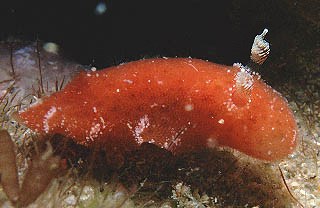
Dear Bill,
Once again I'm in need of help. This time the specimen is a species of Rostanga that I photographed on 16 December 2001 while on a night dive at Portsea Pier, Victoria, Australia. The specimen was 15mm in length and was found on the bottom beneath the pier at a depth of 4m.
Is this Rostanga calumus or is it R. arbutus? Are there any distinguishing external features that may be used to separate these two species?
Any help would be appreciated.
Best wishes,
John.
jchuk@giant.net.au
Chuk, J., 2002 (Feb 8) Rostanga calumus from S.E. Australia. [Message in] Sea Slug Forum. Australian Museum, Sydney. Available from http://www.seaslugforum.net/find/6057Dear John,
This was one of the messages that forced me to prepare some pages on this genus. The short answer is I am pretty sure that this is R. calumus. Although there are many records of R. arbutus from southern Australia, as far as I can determine it does not occur further south than southern New South Wales. One fairly good external difference is that R. arbutus has fairly 'typical dorid' shaped rhinophore clubs which taper gradually to the tip and have nearly horizontal lamellae. In R. calumus the rhinophore clubs, as can be seen in your photo, have a flat-topped club in which the lamellae are almost vertical. Both your photos and mine show dull brownish patches scattered over the orange-red mantle. I am not sure if that will prove to be a good character for the species, as we have not seen enough material to be sure.
We have only one report of the egg ribbon of this species but it is enough to show it is quite different from that of R. arbutus. So any photos of species ofRostanga on sponges and associated with egg masses would be very welcome.
When I first started looking at Rostanga in the Pacific it was thought that there was only one species, Rostanga arbutus, from Australia to Japan and across to the Red Sea. When Geoff Avern and I published our review, we showed there were at least 9 species, 7 of them new. They can be distinguished on radular morphology, sponge diet, shape of egg ribbon and development type, and to some extent on rhinophore shape. Unfortunately what can't be used is their external colour, which is why it is very difficult to identify species of Rostanga from photographs.
They are a perfect group to illustrate how important it is to try and get information on aspects of these animals' natural history such as their food and their egg ribbons. The only other way to confidently identify them is to kill them, cut them open and look at their teeth - which is not a very useful technique if you want to study them alive.
Best wishes,
Bill Rudman
